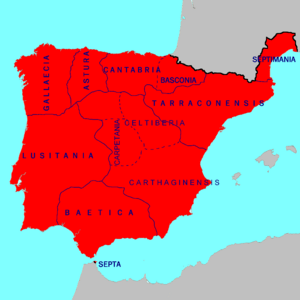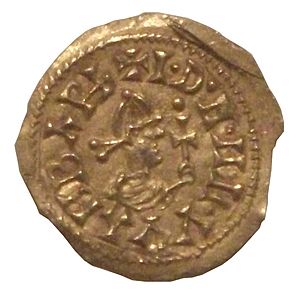Flavius Paulus facts for kids
Quick facts for kids Paulus |
|
|---|---|
| King of Septimania | |
| Reign | Spring – 3 September 673 |
| Predecessor | Hilderic? |
| Successor | Wamba (Visigothic Kingdom) |
| Died | Before 683? |
Paulus or Paul was a Roman general who served the Visigothic Kingdom in the 600s. In 673, Paulus joined the Visigothic king Wamba (r.672–680) on a military trip. They were fighting against the Basques. But then, news arrived about a rebellion led by a count named Hilderic in a region called Septimania. This was the northern and eastern part of the kingdom.
King Wamba sent Paulus with many soldiers to stop the rebellion. However, when Paulus got to Septimania, he changed his mind. He decided to join the rebels instead! He even became their leader and was crowned as king. Paulus became very powerful in Septimania and a nearby area called Tarraconensis. This was probably because his army was large. Also, these two regions were some of the last parts of the kingdom that still felt very "Roman." Paulus called himself the 'king of the east' (rex orientalis). He ruled from Narbonne and wanted to break away from the Visigothic Kingdom's main control.
Paulus had a lot of support. His own Visigothic soldiers joined him. Also, local people like the Goths, Franks, Gallo-Romans, and Hispano-Romans in Septimania helped him. Even the local Jewish community supported him. Paulus's rebellion was a big threat to the Visigothic Kingdom. He might have even planned to take over all of Hispania (modern-day Spain and Portugal). After ruling for several months, Paulus was defeated and captured on September 3, 673. King Wamba did not execute him. Instead, Paulus was publicly shamed in a special parade in Toledo, the Visigothic capital. He was then put in prison. Later, in 683, Wamba's successor, Erwig (r.680–687), pardoned the nobles involved in the revolt. But Paulus might have already died by then.
Contents
Who Was Paulus?
Given his name, Paulus was likely from a Roman family, not a Gothic one. He lived about 200 years after the fall of the Western Roman Empire. At this time, the idea of being "Roman" was fading in Western Europe. In Paulus's time, Goths and Romans lived side-by-side in the Visigothic Kingdom. Even though Romans were less often mentioned, some could still become generals in the Visigothic army. For example, in the 580s, a Roman general named Claudius helped a Visigothic king stop a rebellion.
The Visigothic kings were usually chosen by election. But often, the king's son would take over. Most Visigothic kings either inherited the throne or took it by leading a revolt. Romans could hold important jobs in the army and government. However, they were not allowed to become king. Visigothic laws said that only a Gothic noble could be king. Revolts by nobles trying to remove the king were quite common back then.
Paulus's Story
How the Rebellion Started

Paulus was a general serving King Wamba (r.672–680). Wamba became king in 672. He was an older man, chosen because he was highly respected. Not much is known about Wamba before he became king. But he was likely an important person in the Visigothic court. Wamba wanted to make his position as king stronger. So, in the spring of 673, he led his army against the Basques. The Basques often raided the northern parts of the kingdom.
While Wamba was fighting, he heard about a rebellion in Septimania. This was a serious problem. It wasn't just a simple peasant uprising. It was led by Hilderic, the governor of Nîmes. Hilderic might have even declared himself king. The exact reasons for his revolt are not clear. But he probably wanted to break free from the Visigothic king's control. Hilderic was a Visigoth, like Wamba. His main supporters included a bishop, local Visigothic soldiers, and the local Jewish people. The Jewish community was eager to fight against the strict religious rules imposed by the Visigothic kings. Hilderic might have also sought help from the Basques and the Franks.
Hilderic did not control all of Septimania. So, Wamba and his advisors decided they didn't need to stop fighting the Basques. They sent a smaller army to deal with Hilderic. Paulus was chosen to lead this army. This is the first time Paulus is mentioned in history. He was chosen because he was a skilled and brave fighter. Paulus was made the military leader of Septimania. He led thousands of men from the Basque regions towards Septimania. On his way, he met another leader in Barcelona. Paulus's rebellion is one of the best-recorded revolts of that time. This is thanks to detailed writings by Julian of Toledo.
Paulus Becomes King

When Paulus arrived in Septimania, he did something unexpected. He ignored Wamba's orders. Instead, he became the leader of the rebels! He was declared king, even though laws said only Goths could be king. Paulus was the first Roman to rebel against Visigothic rule in a long time. His revolt was a big threat to the Visigothic Kingdom. We don't know why Paulus betrayed Wamba.
Other important people joined Paulus. At Narbonne, Paulus gathered his army leaders and local important people. He convinced them to choose him as king. He said Wamba was a "tyrant." Paulus's crowning followed all the usual Visigothic traditions. It was important that he was crowned in Narbonne. This city had an Archbishop, making it as important religiously as Toledo, the Visigothic capital. Paulus was crowned with a special golden crown. It had been given to a saint's body by an earlier Visigothic king. An Archbishop likely crowned him. Hilderic, who might have called himself king earlier, joined Paulus and accepted him as his ruler. The most simple reason for Paulus's wide support was that his army was the only large military force in the area.
Wamba learned about Paulus's rebellion while still fighting the Basques. He waited a week to defeat the Basques first. This gave Paulus time to get stronger. Wamba then split his army into three groups. They attacked over the Pyrenees mountains. Paulus knew he couldn't beat Wamba's army alone. He sent messages asking other countries for help. But the Basques refused. The Franks also said no because they had their own problems. Paulus even asked the Byzantine Empire for help. But they couldn't send aid because of an upcoming attack on their capital.
Wamba quickly took back Barcelona. He then rested his army near the Pyrenees. There, Wamba received a challenging letter from Paulus. Paulus called himself rex orientalis (the "eastern king"). He called Wamba rex australis (the "southern king"). Paulus dared Wamba to enter his land and take his crown. He even challenged Wamba to a single combat (a fight between just two people).
Paulus's offer might have meant he wanted to divide the kingdom. He might have wanted to be king of the east, leaving Wamba as king of the south. These regions had been ruled by separate kings before. But it's also possible that Paulus planned to take over the whole kingdom later. Wamba did not accept Paulus's challenge to single combat. Wamba's forces fought and defeated an army led by one of Paulus's allies. They captured two of Paulus's main supporters. Then, Wamba marched towards Narbonne, where Paulus was waiting.
When Paulus heard how big Wamba's army was, he ran away from Narbonne. He retreated to Nîmes. He left another soldier, Wittimir, to defend Narbonne. Wittimir fought bravely for three hours until Wamba's soldiers broke through the city walls. Wittimir kept fighting fiercely inside the city. After three more hours, he retreated to a church to rest. There, Wamba's men captured him. After this, Wamba began marching to Nîmes.
The End of the Revolt
At Nîmes, Paulus led the defense. His forces included Visigoths, Gallo-Romans, and even some Franks. For two days, Wamba could not break through the city's defenses. On the third day, Wamba decided to lead the attack himself. He brought most of his army to the fight. In old records, Paulus spoke badly of Wamba and his army, calling them only 'Goths.' This is interesting because many of Paulus's own supporters had Gothic names. This suggests that Paulus's army might have had more Romans than people thought. Perhaps the rebellion partly started because Hispano-Romans wanted to be free from Visigothic rule. Septimania and Tarraconensis were the most "Roman" parts of the Visigothic kingdom.
Wamba's final attack was successful. As the Visigoths broke through the defenses, Paulus and his men hid in a local amphitheater. Wamba's forces surrounded them again. But before Wamba even had to attack, Paulus's soldiers started to distrust each other. They feared betrayal. His Frankish, Gothic, and Roman soldiers began fighting among themselves. Seeing that his rebellion was over, Paulus, Archbishop Argebad, and other leaders surrendered to Wamba on September 3, 673. Wamba's soldiers entered the amphitheater. They chained those who surrendered and killed those who did not.
What Happened Next
On September 6, 673, Paulus and his main followers were judged by Wamba. Paulus was accused of starting a rebellion and breaking his promise of loyalty to the king. Wamba spared the lives of Paulus and his men after they admitted they were guilty. Wamba replaced all the officials who had rebelled. He made sure his control over Septimania was strong by placing soldiers in the larger cities. To deal with the Jewish people, who had strongly supported the uprising, Wamba forced them out of Narbonne. He even suggested ending Judaism in his kingdom by making Jewish children be baptized and taught Christianity.
Paulus was saved from the worst punishments. But he did not go completely unpunished. Paulus and his main supporters were publicly shamed. They were forced to be part of Wamba's special parade in Toledo. They were paraded through the streets. The rebels' heads were shaved, and their beards were cut off. They wore dirty robes and had to walk barefoot. They were put on chariots pulled by camels. Since Paulus had been the leader and called himself king, his head had a fake crown. It was either made of black leather or fish bones, depending on the story. After this, Paulus and his followers were put in prison.
Ten years later, in 683, Wamba's successor, King Erwig (r.680–687), pardoned everyone who had been found guilty of rebelling against Wamba. It's possible that Paulus was freed because of this pardon. But he was probably old by then. He seemed to have been an important noble even in the 650s. So, it is more likely that he died while he was in prison.
See also
 In Spanish: Paulo para niños
In Spanish: Paulo para niños

